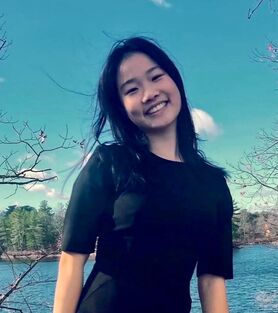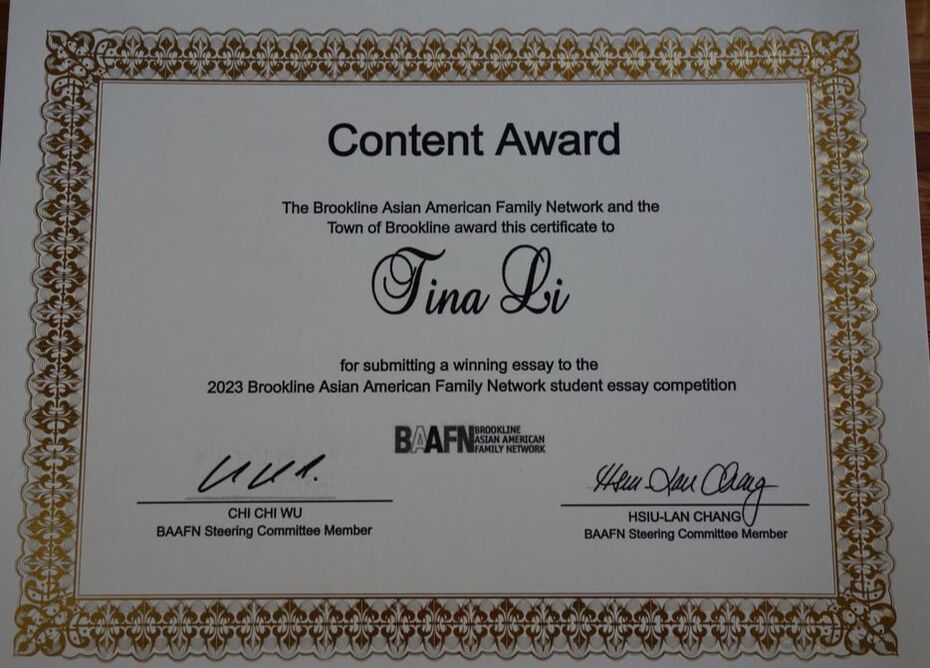2023 Content Award
Why Do I Hate Wearing Red Clothes?
by Tina Li
Red used to be my favorite color, symbolizing joy, prosperity, and power. I loved wearing red clothes, from traditional red qipao, to scarlet hand-woven hats. But how did they slowly get piled into the depths of my closet, never to be worn again? What changed, making me hate or even fear wearing red clothes?
A one-way plane ticket to the United States.
Growing up in China, my parents frequently glorified the United States as the lighthouse of democracy and opportunities. However, the idea of leaving my home country did not become real until a final meeting with the immigration officer on my 12th birthday and a red stamp on my passport, granting my family permission to immigrate here. The following six months were a blur. I dropped out of school, my parents quit their job, we sold the house that I grew up in, and we packed up our entire life into thirteen suitcases. Then, on March 8, 2018, after an 18-hour flight, I landed at the Boston Logan Airport on a snowy winter night.
A few days after I arrived in Brookline, I started 6th grade at Pierce. Despite my inability to communicate in English, I quietly observed my fellow classmates and took in everything with wonder. Just by my first impression, I was overwhelmed by how different I felt compared to them. They were loud, confident, and American, while I was quiet, scared, and Chinese.
But at that time, I couldn’t pinpoint what made me feel that way. I only saw that those girls were wearing stylish black tank tops, while I was wearing an ugly red sweater that my grandmother made. Even before I understood the social norms and beauty standards of this new place, I knew that red made me different, and I felt ashamed because of it.
For the next few years, I envied those “American girls” and was desperate to be like them, which, to the 12-year-old me at that time, meant changing my appearance, especially by not wearing red. I tried wearing tank tops, putting on mascara, and shoved my red clothes onto the bottom of my closet. Yet, despite how hard I tried, I never fit in among the white “popular” girls. To them, I was always the shy Asian girl who could not speak English. Not knowing anyone who could relate to me, I felt alone, invisible, and powerless.
Then one day in 8th grade, we were learning about immigration during history class, and my teacher Ms. Lattin pulled me aside after class to ask about my story. I could have brushed it off like I normally would. But perhaps because of her kind smile, I told her everything, from the moment I knew my life would change to the final goodbye with my grandparents. After hearing my story, Ms. Lattin said with tears dancing in her eyes that “That’s so powerful, Tina. I’m proud of you”. I nodded, trying to hold back my tears.
At that moment, I realized that I had power in my own story. I did not have to pretend to be like my white American classmates. Because I was not. My Asian immigrant identity, from my red clothes to my Chinese accent, was precisely what made me “me”. And I should not feel the need to hide it away.
Ever since then, I began wearing more red clothes and joined the Asian Pacific American Club. Slowly, I met more people who had similar experiences as me. I saw so many of them embracing their Asian identities, in such an unapologetic and liberating way. I realized that I am not alone; I am not the only one who once feared wearing red clothes, and I did not have to anymore.
I wish I could say embracing my identity as an Asian American was a linear path. But sometimes the internal battle of wearing red clothes or not still feels like my two identities are battling for attention. But more than anything, I often remind myself how proud I am to be both Chinese and American. My Chinese uprising and background taught me to be hardworking, grateful, and kind, while my American immigrant experience taught me to be confident, bold, and fight for my voice to be heard. These two identities are never the polar opposite like I thought; Instead, they match perfectly together, like my red qipao and white Converse, into me, the person I am today.
A one-way plane ticket to the United States.
Growing up in China, my parents frequently glorified the United States as the lighthouse of democracy and opportunities. However, the idea of leaving my home country did not become real until a final meeting with the immigration officer on my 12th birthday and a red stamp on my passport, granting my family permission to immigrate here. The following six months were a blur. I dropped out of school, my parents quit their job, we sold the house that I grew up in, and we packed up our entire life into thirteen suitcases. Then, on March 8, 2018, after an 18-hour flight, I landed at the Boston Logan Airport on a snowy winter night.
A few days after I arrived in Brookline, I started 6th grade at Pierce. Despite my inability to communicate in English, I quietly observed my fellow classmates and took in everything with wonder. Just by my first impression, I was overwhelmed by how different I felt compared to them. They were loud, confident, and American, while I was quiet, scared, and Chinese.
But at that time, I couldn’t pinpoint what made me feel that way. I only saw that those girls were wearing stylish black tank tops, while I was wearing an ugly red sweater that my grandmother made. Even before I understood the social norms and beauty standards of this new place, I knew that red made me different, and I felt ashamed because of it.
For the next few years, I envied those “American girls” and was desperate to be like them, which, to the 12-year-old me at that time, meant changing my appearance, especially by not wearing red. I tried wearing tank tops, putting on mascara, and shoved my red clothes onto the bottom of my closet. Yet, despite how hard I tried, I never fit in among the white “popular” girls. To them, I was always the shy Asian girl who could not speak English. Not knowing anyone who could relate to me, I felt alone, invisible, and powerless.
Then one day in 8th grade, we were learning about immigration during history class, and my teacher Ms. Lattin pulled me aside after class to ask about my story. I could have brushed it off like I normally would. But perhaps because of her kind smile, I told her everything, from the moment I knew my life would change to the final goodbye with my grandparents. After hearing my story, Ms. Lattin said with tears dancing in her eyes that “That’s so powerful, Tina. I’m proud of you”. I nodded, trying to hold back my tears.
At that moment, I realized that I had power in my own story. I did not have to pretend to be like my white American classmates. Because I was not. My Asian immigrant identity, from my red clothes to my Chinese accent, was precisely what made me “me”. And I should not feel the need to hide it away.
Ever since then, I began wearing more red clothes and joined the Asian Pacific American Club. Slowly, I met more people who had similar experiences as me. I saw so many of them embracing their Asian identities, in such an unapologetic and liberating way. I realized that I am not alone; I am not the only one who once feared wearing red clothes, and I did not have to anymore.
I wish I could say embracing my identity as an Asian American was a linear path. But sometimes the internal battle of wearing red clothes or not still feels like my two identities are battling for attention. But more than anything, I often remind myself how proud I am to be both Chinese and American. My Chinese uprising and background taught me to be hardworking, grateful, and kind, while my American immigrant experience taught me to be confident, bold, and fight for my voice to be heard. These two identities are never the polar opposite like I thought; Instead, they match perfectly together, like my red qipao and white Converse, into me, the person I am today.



